Introduction
Implementing an Electronic Quality Management System (eQMS) is crucial for organizations seeking to ensure FDA compliance. By digitizing quality management processes, an eQMS streamlines workflows, enhances accuracy, and strengthens regulatory standards. This article explores the benefits of integrating an eQMS, including documentation control, process optimization, regulatory alignment, educational resources, and risk management.
It also discusses the centralization and automation of quality processes, enhanced document control and traceability, integration of corrective and preventive action (CAPA) processes, risk management throughout the device lifecycle, streamlined audits and regulatory assessments, improved visibility and transparency for stakeholders and regulators, cost-effectiveness and scalability of eQMS solutions, compliance with FDA and international regulations, and validation and security considerations for eQMS. By embracing an eQMS, organizations can enhance their quality systems, meet FDA requirements, and stay at the forefront of modernization and efficiency in the medical device industry.
Benefits of Implementing an Electronic Quality Management System (eQMS) for FDA Compliance
Incorporating an electronic Quality Management System into your organization is a crucial step in maintaining FDA compliance. Digitization of quality management processes not only streamlines the workflow but also fortifies the accuracy and reliability of meeting regulatory standards. The benefits of deploying an eQMS include:
- Documentation Control: An eQMS centralizes and manages critical documents, such as those evaluated to determine if an event was reportable or the documentation of decision-making processes regarding device-related incidents, as outlined in 21 CFR 803.18(b)(1)(i).
Through the application of Regulatory Design Thinking, process optimization ensures that an electronic quality management system is designed based on the user's requirements, resulting in human-centered processes that lead to improved results and ease of regulatory compliance.
- Regulatory Alignment: The FDA's Quality System Regulation for Devices, Part 820, and its harmonization with international standards such as ISO 13485, is essential for global market access. A quality management system ensures alignment with these regulations, providing a clear path to compliance and fostering global regulatory cooperation.
Educational Resources and Community Engagement: The Global Medical Device Podcast and resources like the Quality Digest provide valuable insights from industry experts, contributing to a more informed approach towards excellence management and FDA compliance.
- Risk Management: ISO 14971:2019 emphasizes the application of risk management to medical devices. A quality management system supports this by providing a systematic approach to risk assessment, ensuring consistent documentation and adherence to safety standards.
By adopting an automated, electronic approach as suggested by regulatory bodies, companies can greatly improve their systems, ensuring they are ready for inspections and audits while maintaining the high standards necessary for medical device safety and efficacy. Moreover, as medical device and life sciences companies transition from manual validation processes to more automated systems, they remain abreast with the FDA's push towards modernization and efficiency.

Centralization and Automation of Quality Processes
The implementation of an Electronic Quality Management System represents a significant advancement for organizations in the MedTech industry and beyond, offering a centralized and automated solution for managing quality processes. By bringing together all quality-related activities and documentation in one digital system, a quality management solution enhances accessibility and reduces the chance of manual mistakes, promoting consistency across the organization. Automated workflows and alerts streamline the review and approval processes, enhancing efficiency and diminishing the burden of manual, time-intensive tasks.
In practice, enterprise companies with extensive product lines and global workforces find traditional QMS solutions inadequate. For such entities, an enterprise eQMS becomes indispensable, ensuring the safety and efficacy of products through a systematized approach to documents, policies, procedures, and processes. The implementation of a digital system must be guided by clear objectives and realistic goals to align with the overarching strategy, culminating in a phased rollout that leverages successes from earlier digital transitions.
Recent industry news reflects a move towards automation in management, prompted by regulatory agencies like the FDA. With a focus on improving the standard, safety, and effectiveness of medical devices, the FDA is aligning its Quality System regulation with international standards such as ISO 13485, thereby promoting global harmonization. This alignment underscores the importance of document control as set forth in Section 4.24 of ISO 13485:2016, which mandates rigorous review and approval of documents, further necessitating compliance with regulations such as 21 CFR Part 11 concerning electronic signatures.
The importance of this transformation is strengthened by the discoveries from the 15th edition of the World Quality Report, which highlights the industry-wide focus on agile management, lifecycle automation, and data security. By utilizing a quality management system, organizations can guarantee the integrity and confidentiality of data, a critical aspect in an era where data security and privacy are of utmost importance.
For industry leaders, adopting a comprehensive system for managing healthcare standards is a crucial move towards shaping the future of healthcare management. It is an opportunity to be at the forefront of change, improving patient care through the adoption of cutting-edge quality systems that are both precise and efficient.
Enhanced Document Control and Traceability
Ensuring compliance with FDA regulations is a multifaceted challenge that involves meticulous document control and traceability. An Electronic Quality Management System addresses these challenges directly by offering extensive document management capabilities. Such systems facilitate the creation, revision, and distribution of controlled documents with precision and ease. Significantly, the incorporation of version control, electronic signatures, and audit trails by a quality management system maintains the integrity of documents and promotes compliance with FDA regulations.
Additionally, the electronic quality management system improves traceability—an essential component emphasized by the Food and Drug Administration's Food Traceability Final Rule, a crucial aspect of the FDA Food Safety Modernization Act (FSMA). This rule signifies a leap forward in public health protection by enabling quicker identification and removal of potentially contaminated food from the market. A quality management system, therefore, plays a crucial role in maintaining accurate records of shipping and receiving, events critical in the food supply chain that are defined and regulated by the FDA. This rigorous tracking ensures that each product's journey, from one location to another, is meticulously recorded and that the products received are verified against the records.
As the landscape of rules and requirements advances and the need for digital health solutions, including Software as a Medical Device (SaMD), keeps growing, the importance of a quality management system for electronic records becomes more and more noticeable. With the Same market expected to grow exponentially, the need for streamlined, reliable documentation and traceability systems is clear. The software serves as an essential tool in the validation of software used in medical devices and assurance systems, aligning with the FDA's push towards automation and digitalization of regulatory processes.
Considering these advancements, it is crucial to acknowledge that a quality management system not only guarantees effective document retrieval and reduces the hazards linked to misplaced or outdated documents but also aids in meeting the FDA's rigorous standards throughout the industry. This includes compliance with ISO 13485:2016's Section 4.2.4 on the control of documents and 21 CFR Part 11 regarding electronic signatures. By incorporating a management system into their operations, organizations can confidently navigate the intricacies of FDA compliance, ensuring both high standards and public health.
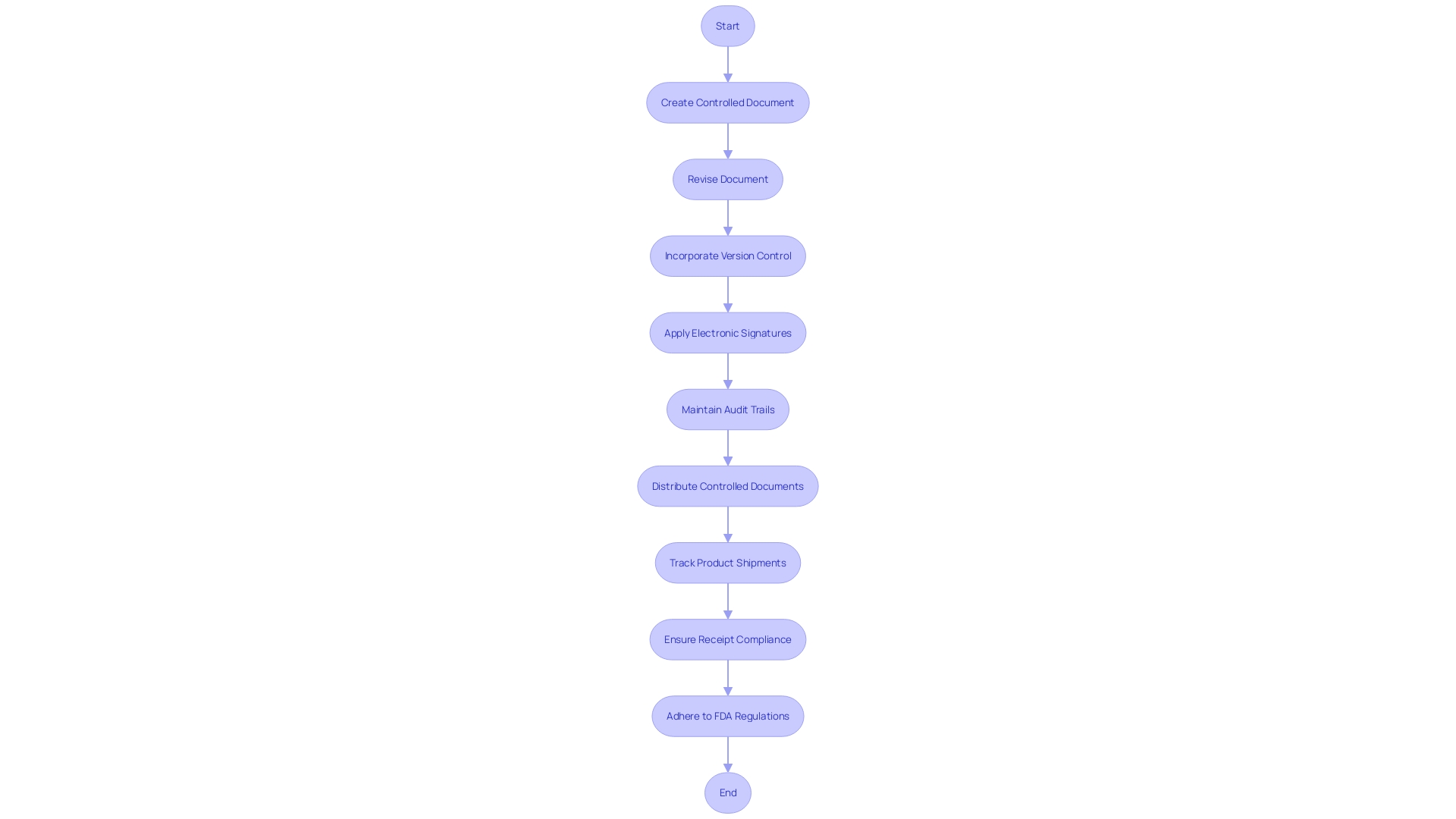
Integration of Corrective and Preventive Action (CAPA) Processes
In the realm of quality management, the CAPA process is a cornerstone for addressing deficiencies and promoting advancement. By integrating CAPA into an electronic Quality Management System, it enhances an organization's ability to manage non-conformances and other quality-related events. Through the automation of workflows, an eQMS facilitates prompt initiation of investigative actions, the application of corrective measures, and the monitoring of their effectiveness over time. Such systematic integration is crucial for fostering a culture of proactive management, diminishing the likelihood of recurring issues, and evidencing a commitment to continual enhancement.
Recent advancements within the FDA, such as the reorganization of its Office of Pharmaceutical Quality to streamline inefficiencies, highlight the significance of agile and responsive management systems. Moreover, the ISO 13485 certification acquired by HBK's Suzhou site emphasizes the global recognition of strong systems that uphold medical device standards. Incorporating CAPA into a quality management system not only conforms to these industry trends but also establishes a standard for other companies to follow in implementing effective quality control and compliance.
Risk Management Throughout the Device Lifecycle
With the medical device industry rapidly evolving, particularly in the realm of automation and artificial intelligence (AI), manufacturers face the challenge of navigating a complex regulatory environment. The integration of automation technology, as forecasted by experts, is essential for the future of the sector, yet it must align with stringent legal requirements. An Electronic Quality Management System (Electronic QMS) becomes indispensable in this regard, providing a structured platform for risk management throughout a medical device's lifecycle. A quality management system enables the development of risk matrices and the implementation of risk assessments to control and reduce potential hazards. This is crucial for not only enhancing patient safety but also ensuring strict adherence to regulations. Industry veterans like Bijan Elahi, with extensive experience in safety risk management, emphasize the importance of clarity and confidence in risk management practices. The quality management system serves as a tool to ensure that any changes to a device, whether in form, fit, or function, are thoroughly documented and meet regulatory standards. In a field where even small changes can greatly affect the risk profile of a device, the quality management system aids in maintaining compliance during innovation. As healthcare technology continues to thrive, with regions like Michigan excelling in talent and manufacturing, and the UK healthcare sector expanding, the importance of a quality management system in ensuring efficient and compliant operations becomes increasingly crucial. It is not only a means to manage risk but also a strategic asset in positioning manufacturers for success amidst a dynamic landscape of regulatory expectations and technological advancements.
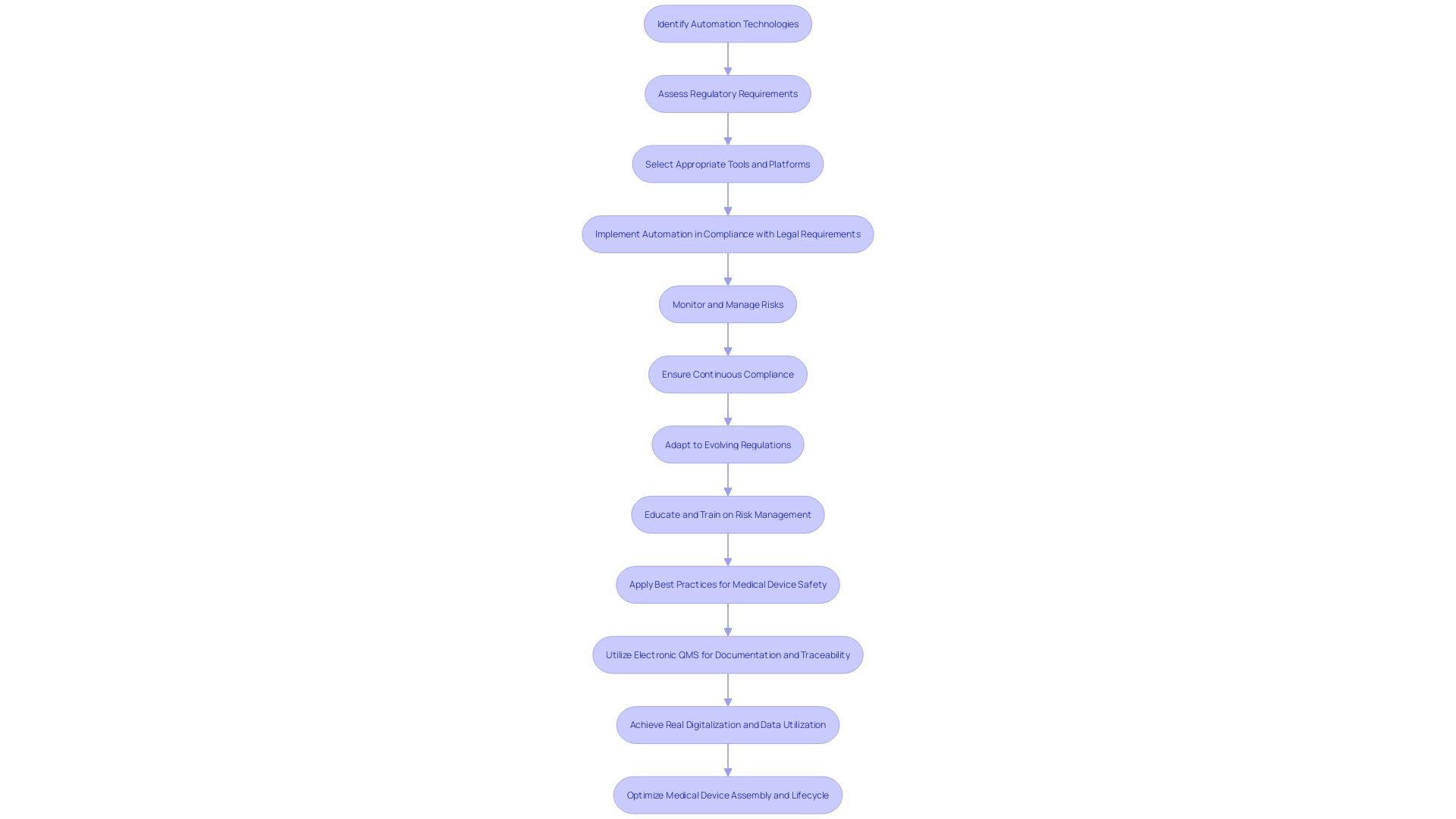
Streamlined Audits and Regulatory Assessments
Implementing an Electronic Quality Management System (eQMS) can convert the challenging task of FDA compliance into a streamlined and efficient process. Central to this transformation is the system's ability to serve as a centralized repository for all quality-related information, which is critically important for medical device manufacturers in light of ISO 14971:2019. This standard delineates the requirement for comprehensive risk management documentation, which a quality management system can uphold diligently, guaranteeing that all data for IVD device certification, for example, is up-to-date and easily accessible.
Furthermore, as the medical device industry moves away from manual validation procedures, a electronic quality management system can enable a more automated and cohesive approach to compliance, in accordance with FDA recommendations. This not only enhances the readiness for audits but also ensures that all necessary corrective actions are managed effectively in real-time. The importance of such a system is underscored by recent industry events, such as the conviction of executives for misleading investors about a healthcare startup's financial health, which could have been mitigated with transparent and accessible quality management practices.
A quality management system also aids the FDA in ensuring the safety, effectiveness, and security of medical devices, thus protecting public health. It aligns with strategies that rely on comprehensive assessments, such as the Q-submission process, to navigate FDA databases and establish clear pathways for product approvals. By adopting an electronic quality management system, organizations can not only meet but exceed regulatory requirements, thus contributing to the delivery of high-quality medical devices that improve patient outcomes.
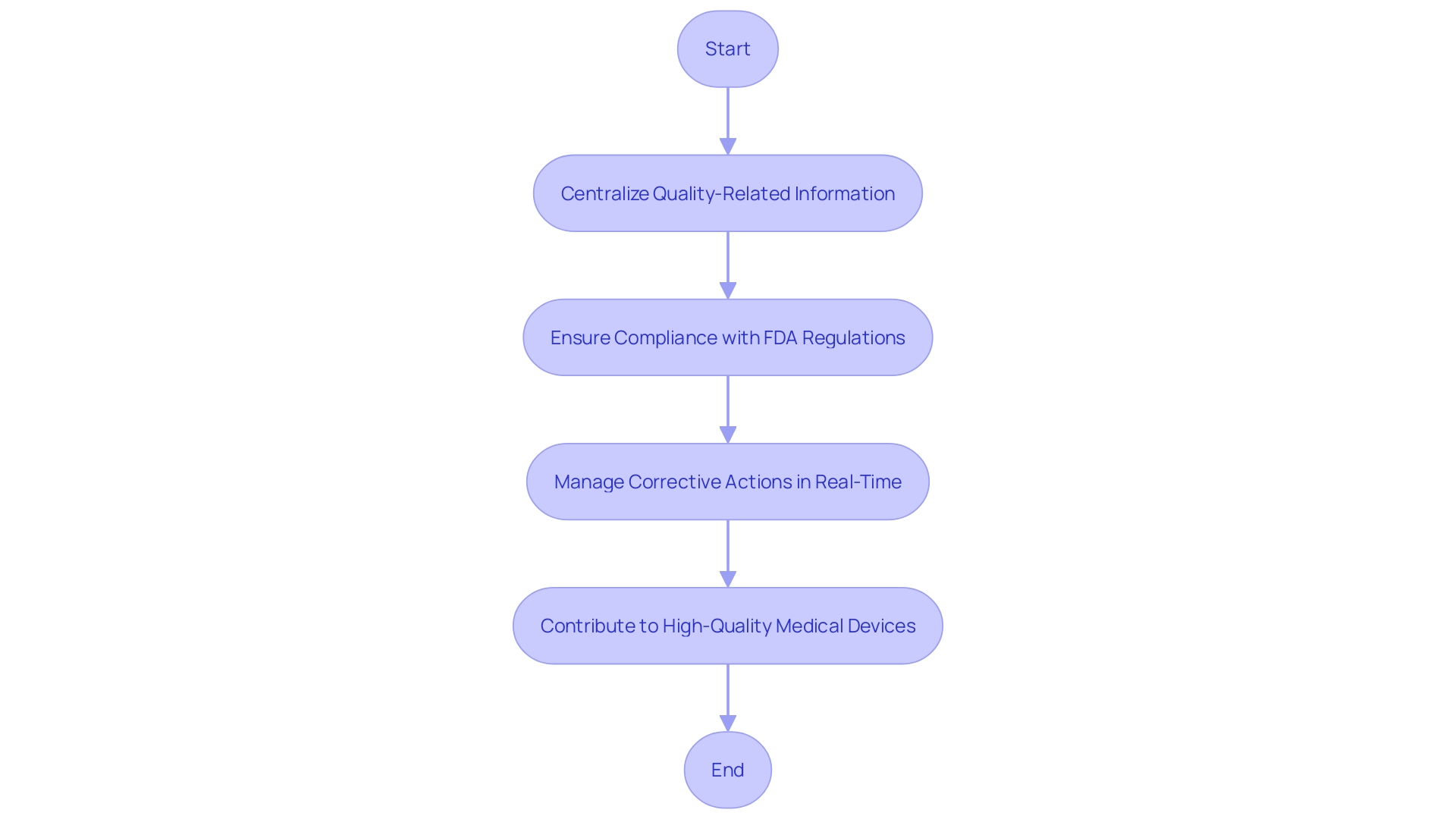
Improved Visibility and Transparency for Stakeholders and Regulators
An Electronic Management System (eQMS) is a pivotal tool in the intersection of technology and compliance. Its capacity to provide stakeholders with immediate insights into quality data and metrics is invaluable for informed decision-making and ongoing monitoring of quality performance. It also streamlines the process of engaging with governing bodies by simplifying the assembly and delivery of comprehensive documentation during audits and submissions. Such transparency and visibility cultivate a relationship of trust and credibility with both stakeholders and overseers, which is vital for strengthening an organization's commitment to standards.
MedTech companies, for instance, must navigate intricate landscapes to maintain compliance, as evidenced by ISO 14971:2019, which outlines rigorous documentation requirements for medical devices. By implementing a strong electronic Quality Management System, organizations can synchronize their data gathering and examination approaches, guaranteeing that their clinical assessment reports, risk mitigation documents, and post-market monitoring data are in line with expectations set by authorities. Moreover, this systemic alignment is not only beneficial for regulatory compliance but also crucial for mitigating business risks, such as security breaches or reputational damage, which can be catastrophic in industries like banking where digital transformation demands the highest levels of security for sensitive data.
The implementation of an electronic Quality Management System (eQMS) can truly be a game-changing approach for businesses that prioritize excellence and adherence to regulations. For instance, Medtronic, a worldwide frontrunner in healthcare technology, utilizes state-of-the-art technologies to tackle health challenges and depends on comprehensive systems to ensure their products are safe and effective. Similarly, Celegence's expertise in Regulatory Affairs emphasizes the importance of tailored strategies and tools like electronic quality management systems (eQMS) to assist businesses in meeting compliance deadlines and maintaining high standards.
Essentially, a quality management system is more than just a compliance necessity; it is a strategic asset that enables businesses to operate with confidence in a regulated environment. Its role in harmonizing documentation, facilitating informed decisions, and ensuring the integrity of quality data underscores its indispensable value in maintaining a robust compliance posture.

Cost-Effectiveness and Scalability of eQMS Solutions
The shift to an Electronic Quality Management System (digital QMS) provides significant advantages in terms of cost-efficiency and flexibility for organizations dealing with the intricacies of FDA compliance. By automating processes and minimizing the likelihood of errors, a quality management system enhances operational efficiency, which can lead to substantial cost reductions. The natural scalability of electronic quality management systems enables organizations to flexibly adapt to evolving business demands and growth, eliminating the requirement for substantial investment in additional resources. Such flexibility is crucial as it ensures the quality management system can progress in tandem with a company, underpinning ongoing compliance with FDA regulations.
Quality, as Henry Ford famously said, is "doing it right when no one is looking." A system that embodies this commitment to excellence, enabling skillful execution through established standards, clear responsibilities, and precise specifications. The system aligns with strategic planning to ensure project success, crucial for industries where product safety and efficacy are non-negotiable, such as in MedTech.
Additionally, for enterprise organizations with extensive product lines and global workforces, the complexity of maintaining a QMS and its records is greatly simplified with enterprise management software. This addresses the need for a robust, integrated approach to document, policy, procedure, and process management across various countries and product ranges, catering to the intricate requirements of large-scale operations.
Adopting an electronic system for managing healthcare standards and processes is a forward-thinking measure for healthcare leaders dedicated to improving patient care and shaping the future of healthcare management. It signifies a transformative approach to upholding the highest quality standards and maintaining compliance with regulations, essential in today's rapidly advancing and highly controlled environments.
Compliance with FDA and International Regulations
Electronic Quality Management Systems have become indispensable in the healthcare sector for organizations aiming to maintain compliance with FDA regulations. These systems offer a structured approach to managing documentation, policies, and processes, which is crucial for both ensuring product safety and effectiveness, and for compliance with regulatory standards.
For instance, under 21 CFR 820.50(a), there is a requirement for establishing and maintaining procedures for products and services to meet specified requirements. A strong electronic quality management system can prevent inadequate practices, such as those seen when firms do not define control frequency over suppliers or fail to maintain records of evaluations, which can lead to non-compliance notices from the FDA.
Furthermore, enterprise quality management system solutions have developed to meet the needs of large companies that operate globally with multiple products and employees. By standardizing processes and securing data integrity, an eQMS enables organizations to not only comply with FDA regulations but also align with international standards like ISO 14971:2019, which is pivotal for global market access.
Organizations have been observed transitioning to more automated systems in response to encouragement for more efficient and reliable compliance methods. For example, an NIH-funded medical school in Florida moved to an independent ServiceNow environment to gain full control over its platform, demonstrating the shift towards specialized solutions that cater to the unique demands of academic and healthcare domains.
The FDA's role in assuring public health by regulating the safety and effectiveness of various products further underscores the need for stringent quality management. As industry professionals adapt to changing landscapes, prioritizing compliance and efficiency has become more evident. This is reflected in the continuous approval of new drugs and biological products by the FDA's Center for Drug Evaluation and Research (CDER), which relies on detailed study designs and comprehensive assessments.
In the end, the incorporation of a quality management system in healthcare organizations is not only about adherence; it's about embracing systems that facilitate the ongoing enhancement and worldwide expansion of medical products and services.
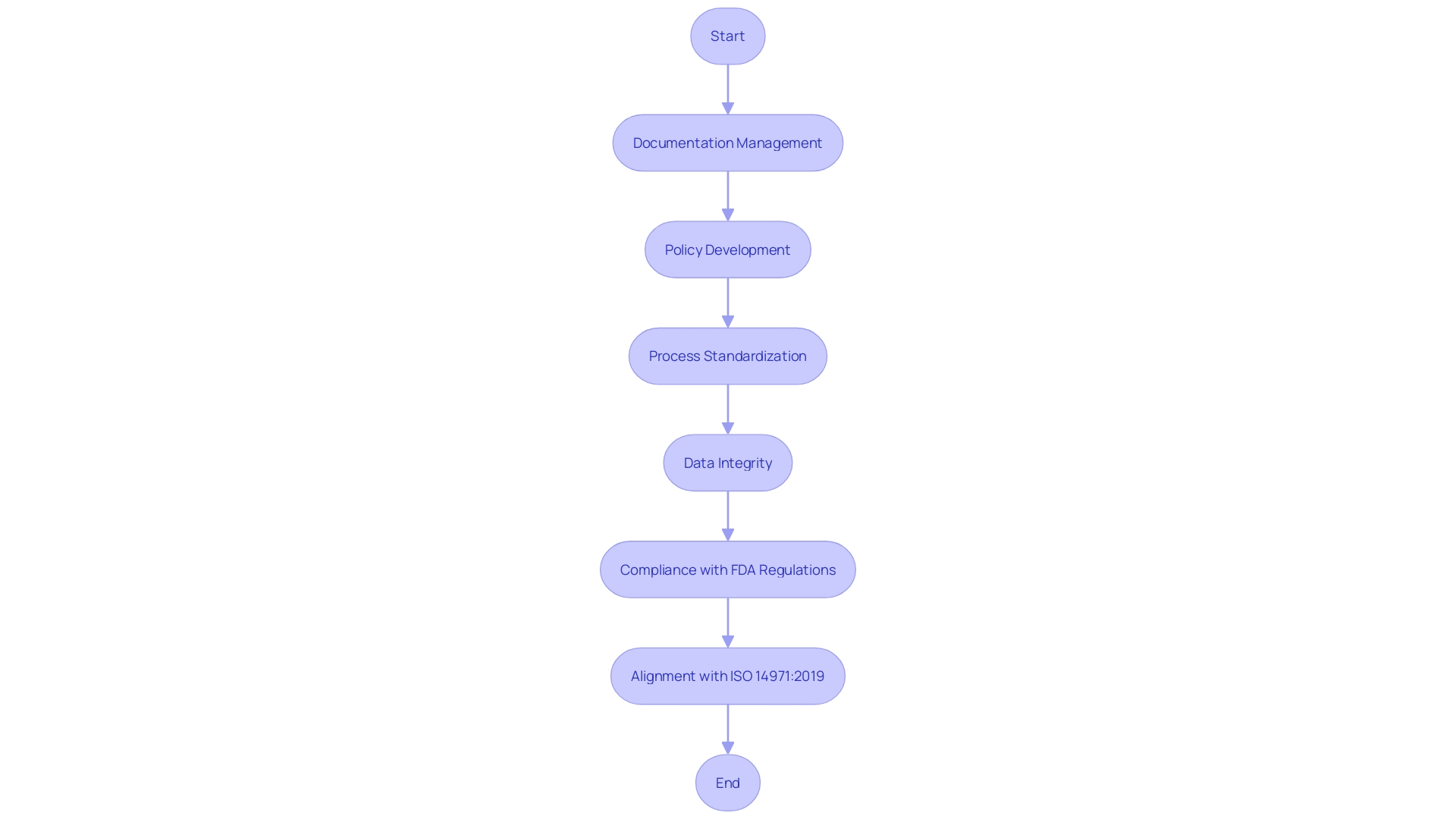
Validation and Security Considerations for eQMS
Making sure that an electronic Quality Management System conforms to regulatory requirements is a critical component of FDA compliance. This involves meticulous validation processes to demonstrate the system's consistency, dependability, and overall performance capabilities. To assure this, organizations must engage in validation tests which include Installation Qualification (IQ), Operational Qualification (OQ), and Performance Qualification (PQ). These rigorous assessments are designed to verify the eQMS's precision and functionality.
Moreover, implementing stringent security protocols is non-negotiable to ensure the protection of sensitive data. Measures such as controlled user access, robust data encryption, and comprehensive audit trails constitute essential safeguards that uphold data integrity. These security measures align with the FDA’s emphasis on the importance of maintaining the quality, safety, and efficacy of medical devices, as reflected in their alignment with ISO 13485 standards.
As per Prasad Ravichandran, an expert in affairs of compliance, getting ready for conformity encompasses a comprehensive comprehension of pertinent documentation and devising customized approaches to fulfill demands of regulations. This preparation is echoed in the FDA's own activities, as they work toward the harmonization of their Quality System Regulation with international standards, enhancing global regulatory congruity.
Moreover, the thoroughness of the FDA's evaluation and documentation of incidents associated with medical devices highlights the importance of a quality management system that can precisely record and handle such crucial information. By fulfilling these requirements, organizations can harness eQMS solutions confidently, ensuring they remain compliant with the FDA's stringent regulations.
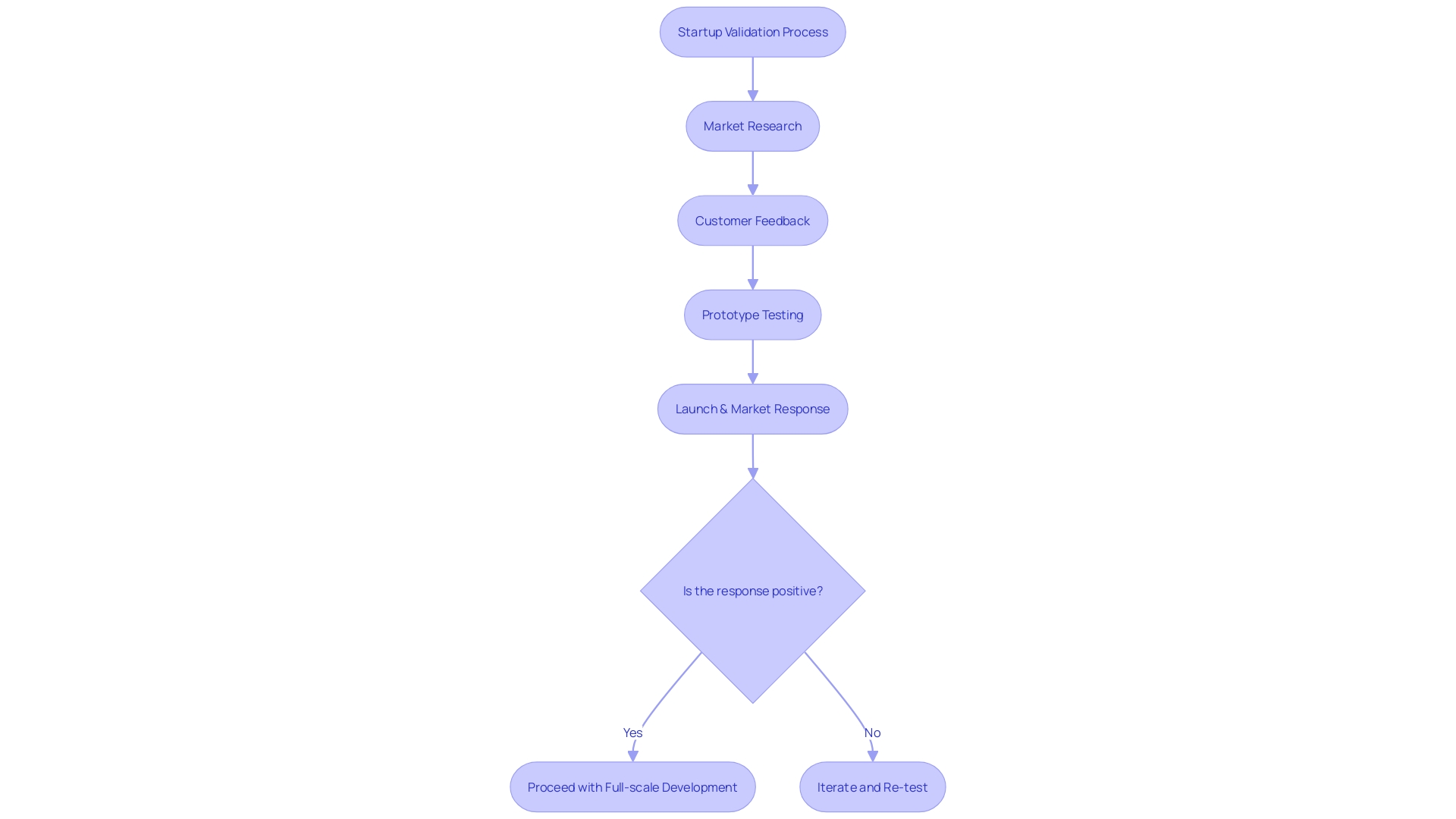
Conclusion
In conclusion, implementing an Electronic Quality Management System (eQMS) is crucial for organizations seeking FDA compliance. An eQMS offers centralized documentation control, optimized processes, and regulatory alignment. It provides educational resources, supports risk management, and enhances visibility for stakeholders and regulators.
Integrating an eQMS streamlines audits, improves document control and traceability, and integrates corrective and preventive action (CAPA) processes. It ensures compliance with FDA and international regulations, offers cost-effectiveness and scalability, and addresses validation and security considerations.
By embracing an eQMS, organizations can enhance their quality systems, meet FDA requirements, and stay at the forefront of modernization and efficiency in the medical device industry. It is a strategic asset that enables businesses to operate with confidence in a regulated environment, delivering high-quality medical devices that improve patient outcomes.




